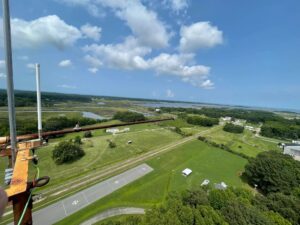
NASA Partners with uAvionix on Command and Control for Urban UAS
Continue reading below, or listen:
by DRONELIFE Staff Writer Ian M. Crosby
NASA has signed a Space Act Agreement with uAvionix for the development of advanced BVLOS Command and Control (C2) technologies for drones in urban environments. The agreement will see NASA collaborate with uAvionix to conduct research & development of commercial UAS C2 systems employing internet-based infrastructure and air traffic control frequencies. Flight testing will be conducted at the UAS Flight Test Range at NASA’s Langley Research Center in Hampton, Virginia, with flight data to be generated and evaluated on the uAvionix SkyLine C2 technology under the High Density Vertiplex (HDV) project.
“The HDV project is excited to partner with uAvionix to support the Advanced Air Mobility (AAM) mission,” said HDV Technical Lead Jacob Schaefer. “C2 technologies are critical to achieve the advanced flight operations envisioned within the future of AAM.”
The new partnership will lend major support to the development of remotely piloted commercial passenger flight operations which are reliant on the performance of certified Control and Non-Payload Communications (CNPC) link systems.
“uAvionix is proud to partner with NASA on this important project”, said uAvionix Managing Director Christian Ramsey. “NASA’s collaboration will help advance the operational application of our skyLink5060 radios, an important step to facilitate AAM, especially passenger carrying vehicles and vertiports that will ultimately require certification.”
The performance and operational standards are currently undergoing testing for use cases that range from Urban Air Mobility to long range cargo delivery. Flight tests are scheduled to take place between the summer of 2023 and summer of 2024, and will incorporate technologies that support advanced BVLOS operations.
Read more:
- Remote ID, No Subscription: uAvionix Announces pingRID Broadcast Module for Any Drone
- Choctaw Nation BEYOND Program Granted BVLOS Approval with uAvionix Installation
- uAvionix wins FAA Approval for BVLOS Flights in North Dakota Drone Network: A First for Vantis
- DroneUp and Elsight Halo: Connectivity for Large Scale Drone Delivery
- Smart City Drone Delivery: DroneUp in Ontario, CA “Community, Connectivity, and Convenience”
Ian attended Dominican University of California, where he received a BA in English in 2019. With a lifelong passion for writing and storytelling and a keen interest in technology, he is now contributing to DroneLife as a staff writer.

Miriam McNabb is the Editor-in-Chief of DRONELIFE and CEO of JobForDrones, a professional drone services marketplace, and a fascinated observer of the emerging drone industry and the regulatory environment for drones. Miriam has penned over 3,000 articles focused on the commercial drone space and is an international speaker and recognized figure in the industry. Miriam has a degree from the University of Chicago and over 20 years of experience in high tech sales and marketing for new technologies.
For drone industry consulting or writing, Email Miriam.
TWITTER:@spaldingbarker
Subscribe to DroneLife here.